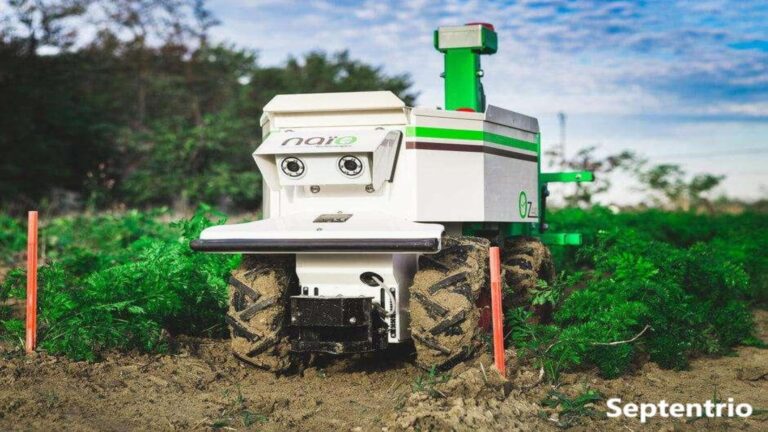Introduction
The relentless pursuit of safety, reliability, and precision in autonomous driving demands positioning solutions that transcend conventional capabilities. Environmental extremes, signal vulnerabilities, and the critical need for uninterrupted, centimeter-accurate location and orientation data are paramount challenges. The Septentrio AsteRx RBi3 Pro+ stands as a purpose-built Resilient GNSS receiver, integrating high-performance GNSS with an Inertial Navigation System (INS), specifically engineered to meet these rigorous demands of the intelligent transportation sector. This Septentrio GNSS/INS receiver is not merely a component; it’s a robust, integrated solution delivering the trusted positioning backbone required for Level 4 and Level 5 autonomy.
Operating reliably in the harshest conditions is non-negotiable for autonomous vehicles navigating industrial ports, mining sites, agriculture, or demanding urban logistics. The AsteRx RBi3 Pro+ excels here with its ultra-rugged IP69K housing, designed to withstand severe chemical exposure, extreme temperature fluctuations (-40°C to +85°C operational), and sustained high mechanical stress and vibration (tested to commercial vehicle unsprung mass levels up to 300m/s²). This inherent physical resilience ensures the Septentrio receiver performs consistently where lesser systems would falter, providing dependable operation vital for safety-critical autonomous applications.
Signal integrity is perhaps the most significant battlefield. The modern RF environment is fraught with challenges, from unintentional interference to malicious GNSS jamming / GPS jamming and sophisticated GNSS spoofing / GPS spoofing attacks. These threats can cripple standard receivers, leading to catastrophic failures in autonomous systems. The AsteRx RBi3 Pro+ integrates Septentrio’s industry-leading Anti Jamming GNSS technology, AIM+. This advanced system continuously monitors the RF spectrum, identifies interference sources (including GPS jammer and drone jammer signals increasingly common in sensitive areas), and actively mitigates their impact, preserving signal tracking and positioning accuracy. Furthermore, its robust signal processing provides inherent resistance against spoofing attempts. This makes the AsteRx RBi3 Pro+ a truly Resilient GNSS receiver, engineered to deliver trustworthy positioning even amidst intentional disruption.
Beyond interference, urban canyons, tunnels, and dense foliage pose natural threats to GNSS signal availability. This is where the integrated INS becomes indispensable. The AsteRx RBi3 Pro+ seamlessly fuses multi-frequency, multi-constellation GNSS data (including GPS, GLONASS, Galileo, BeiDou, QZSS, SBAS) with high-rate inertial measurements from its internal IMU. During inevitable short GNSS outages caused by obstructions, the Septentrio GNSS/INS receiver employs sophisticated dead reckoning algorithms, maintaining continuous, centimeter-level positioning and precise attitude (heading, pitch, roll) estimation. This continuity is critical for autonomous vehicles, ensuring smooth operation and safety through challenging signal environments without relying solely on complex and potentially error-prone sensor fusion from other vehicle systems.
Performance is measured in precision, speed, and reliability. The AsteRx RBi3 Pro+ delivers RTK positioning accuracy at the centimeter level, meeting the stringent requirements traditionally associated with high-end land surveying equipment. Its high update rate of up to 100 Hz for integrated position/attitude and low latency (<20 ms) provides the rapid feedback essential for the dynamic control loops of autonomous vehicles, especially during high-speed maneuvers or sudden direction changes. The dual-antenna configuration capability enables sub-degree, position-independent heading accuracy – available immediately upon startup – crucial for precise vehicle orientation and path following. This performance benchmark rivals specialized drone GPS systems but is packaged for the demanding terrestrial autonomous market.
Integration into complex autonomous driving architectures is streamlined. The Septentrio receiver offers versatile connectivity options including CAN/CAN-FD, Ethernet 10/100 Mbps, USB, and multiple RS232 ports, ensuring compatibility with vehicle control units and sensor networks. Support for standard protocols like NMEA 0183, RTCM v3.x (including MSM), and Septentrio Binary Format (SBF) simplifies data flow. Complementing the hardware, Septentrio’s powerful RxTools software suite provides comprehensive tools for configuration, real-time monitoring, data logging, and diagnostics, significantly accelerating integration, deployment, and maintenance cycles. While offering the precision of an RTK GPS module, the AsteRx RBi3 Pro+ is a complete, integrated GNSS receiver solution designed for seamless incorporation into larger autonomous systems.
In conclusion, the transition towards fully autonomous driving hinges on achieving unprecedented levels of positioning resilience and reliability. The Septentrio AsteRx RBi3 Pro+ is not just a GNSS component; it is a sophisticated Resilient GNSS receiver system. Its unparalleled robustness against environmental stress, cutting-edge Anti Jamming GNSS capabilities via AIM+, seamless GNSS/INS integration for continuous positioning, high-accuracy, high-update-rate performance, and ease of integration establish it as the indispensable positioning foundation. For autonomous vehicle developers and operators demanding unwavering trust in their navigation data under all conditions, this Septentrio GNSS/INS receiver provides the critical confidence needed to push the boundaries of intelligent transportation safely and effectively.




